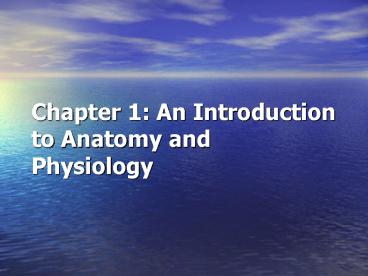Chapter 1: An Introduction to Anatomy and Physiology - PowerPoint PPT Presentation
1 / 40
Title:
Chapter 1: An Introduction to Anatomy and Physiology
Description:
Chapter 1: An Introduction to Anatomy and Physiology Which Direction? Lateral: side view Frontal: front view Anatomical direction: refers to the patient s left or ... – PowerPoint PPT presentation
Number of Views:437
Avg rating:3.0/5.0
Title: Chapter 1: An Introduction to Anatomy and Physiology
1
Chapter 1 An Introduction to Anatomy and
Physiology
2
What is anatomy and physiology?
3
Anatomy
- Describes the structures of the body
- Name
- Location
- Composition
4
(No Transcript)
5
Physiology
- Is the study of
- functions of anatomical structures
6
(No Transcript)
7
What do anatomists and physiologists do?
8
Specialties of Anatomy (1 of 3)
- Gross anatomy, or macroscopic anatomy examines
large, visible structures - surface anatomy
- exterior features
- regional anatomy
- body areas
9
Specialties of Anatomy (2 of 3)
- systemic anatomy
- groups of organs working together
- developmental anatomy
- from egg (embryology) to maturity
- clinical anatomy
- medical specialties
10
Specialties of Anatomy (3 of 3)
- Microscopic anatomy examines cells and molecules
- cytology
- cells and their structures
- cyt cell
- histology
- tissues and their structures
11
Specialties of Physiology
- Cell physiology
- processes within and between cells
- Special physiology
- functions of specific organs
- Systemic physiology
- functions of an organ system
- Pathological physiology
- effects of diseases
12
How are living things organized?
13
From Simple to Complex
- Atoms
- are the smallest chemical units
- Molecules
- are a group of atoms working together
- Organelles
- are a group of molecules working together
14
From Simple to Complex
- Cells
- are a group of organelles working together
- Tissues
- are a group of similar cells working together
- Organs
- are a group of different tissues working together
15
From Simple to Complex
- Organ systems
- are a group of organs working together
- Organism
- is an individual
16
The 11 Organ Systems
- The body is divided into 11 organ systems
- All organ systems work together
- Many organs work in more than 1 organ system
17
KEY CONCEPT
- Homeostasis All body systems working together to
maintain a stable internal environment - Systems respond to external and internal changes
to function within a normal range (body
temperature, fluid balance)
18
KEY CONCEPT
- Failure to function within a normal range results
in disease
19
Mechanisms of Regulation
- Autoregulation (intrinsic)
- automatic response in a cell, tissue, or organ
- Extrinsic regulation
- responses controlled by nervous and endocrine
systems
20
Maintaining Normal Limits
Figure 13
21
Maintaining Normal Limits
- Receptor
- receives the stimulus
- Control center
- processes the signal and sends instructions
- Effector
- carries out instructions
22
Negative Feedback
- The response of the effector negates the stimulus
Figure 14
23
Positive Feedback
- The response of the effector reinforces the
stimulus
Figure 15
24
Working Together
Table 11
25
Working Together
- Systems integration
- systems work together to maintain homeostasis
26
KEY CONCEPT
- Homeostasis is a state of equilibrium
- opposing forces are in balance
- Physiological systems work to restore balance
- Failure results in disease or death
27
What are the anatomical terms used to describe
body sections, regions, and relative positions?
28
Anatomical Landmarks
Figure 16
29
KEY CONCEPT
- Anatomical position
- hands at sides, palms forward
- Supine
- lying down, face up
- Prone
- lying down, face down
30
Quadrants and Regions (1 of 3)
- 4 abdominopelvic quadrants around umbilicus
Figure 17a
31
Quadrants and Regions (2 of 3)
- 9 abdominopelvic regions
Figure 17b
32
Quadrants and Regions (3 of 3)
- Internal organs associated with abdominopelvic
regions
Figure 17c
33
Which Direction?
Figure 18
34
Which Direction?
- Lateral
- side view
- Frontal
- front view
- Anatomical direction
- refers to the patients left or right
35
3 Dimensions
Figure 19
36
3 Dimensions
- Plane
- a 3-dimensional axis
- Section
- a slice parallel to a plane
37
What are the major body cavities and their
subdivisions?
38
The Ventral Body Cavity
- Coelom
- divided by the diaphragm into the thoracic cavity
and the abdominopelvic cavity
Figure 110a
39
Isolating the Organs
- Serous membranes
- consist of parietal layer and visceral layer
Figure 110b
40
Dividing the Cavities
- Thoracic cavity
- divided by the mediastinum into 2 pleural cavities
Figure 110c































